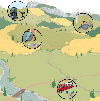Four Killer Campsites for Public Land Elk Hunts
Photo by Donald M. Jones Where to camp is one of the most important decisions you’ll make while elk hunting,...

Photo by Donald M. Jones
Where to camp is one of the most important decisions you’ll make while elk hunting, says Steve Speck, an Idaho big-game hunter and owner of S&S Archery. Camp too close to the action and you’ll blow bulls into the next mountain range. Too far and you’ll spend more time hiking than hunting. “Three things determine the best spot: the terrain, the time of year, and the style of hunting,” Speck says.
Here are his four top campsites for getting on bulls.

Illustration by Robert L. Prince
The High-Saddle Spike Camp
The beginning of archery season is a great time to drop a high-mountain camp above the treeline where you can glass for bulls on their summer feeding pattern, says Speck. “Sleep on the flat of a saddle near a high glassing location to conserve time and energy getting into position in the morning.” This approach is gear intensive, requiring excellent optics, a quality shelter, and performance clothing that’s suitable for rapidly changing weather conditions.
The Herd-Bull Bivouac
In the midseason when elk travel is unpredictable, you want to get on a bull and stay on him. Unlike a base camp or a high spike camp, an ultralight bivouac breaks down every morning, so you can travel on the heels of the herd. “It’s real easy to screw this one up, so when you locate the herd, go silent,” Speck says. “Don’t call until you are almost in shooting range and need to get a bull’s attention.” If the setup isn’t perfect, back out, regroup, and reposition your camp to stay close to the herd. If the setup is perfect, your ultralight pack won’t be so wispy on the way out.
The Backpacker’s Base Camp
Whether it’s early archery or late rifle, a base camp offers more amenities than you’d have going high and light, according to Speck, but is removed enough from the action that you won’t bump elk. “Camp just below the base of drainages next to elky habitat,” he says. “The ideal base camp will let you hunt a variety of elevations and tactics, from spot-and-stalk up high to calling low in the timber. Pack food, water, clothing, and other essentials in your daypack and hunt away from camp until dark each day.”
The Roadside Rut Camp
You can get away with hunting closer to roads during the rut when bulls are more aggressive and spread out and cover more ground in a day, Speck advises. Just be sure to avoid the crowd. “Find river crossings, deep canyons, or other natural barriers that will keep most hunters out, and hunt there. Use a map or GPS that shows property boundaries, and search for good public elk habitat that borders private land. By hunting these fringe areas, you can catch elk seeking refuge on less pressured ground.”